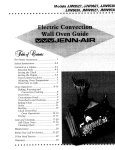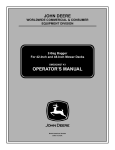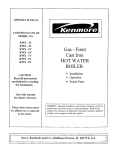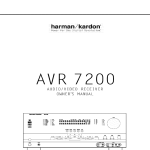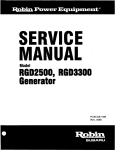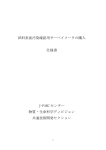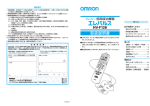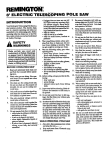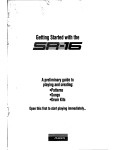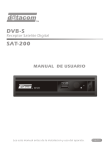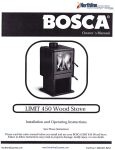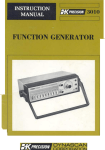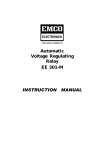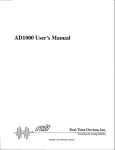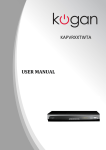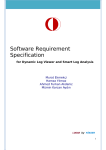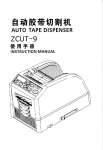Download Here - Kitsrus
Transcript
v
ffi
METE#
Using ultrasonic techniqLtes, this
solid-state design has no moving parts
and does not need calrbrating
wind speed meter (anemometer)
+HIS
I is intended for use in a variety of
I sportstype activities, such as track
events, sailing, hang-gliding, kite and
model aircraft flying, to name but a few. It
can even be used to monitor the conditions
in your garden.
A probe is pointed in the direction from
which the wind is blowing and a screen
displays the rate at which the wind is moving between two ultrasonic sensors. The
readout is shown on an alphanumeric liquid crystal disptay (l.c.d.), i'/ith readings in
metres per second, feet per second, kilometres per hour and miles per hour. The
resolution is to the nearesttenth of a metre
per second,from zero up to around 50mph,
and possibly higher.
The design is one of two spin-offs from
the author's wish to design a totally solidstate (no moving parts) Weather Centre in
which several environmental criteria are
monitored and logged, wind speed and
direction, humidity, barometric pressue,
temperature,rainfall, [ght and UV intensities, air humidity and soil moisture content. The design will be published in a few
months time.
It was concluded that the aerodynamicsof
the car began to take effect above this
speed and it was decided to construct the
second spin-off design - a wind tunnel.
An assembly comprising a cardboatd
tube and an electrically controlled fan was
built. The fan had a known rate of air flow
per minute, the tube had a known crosssectional area and thus the airflow rate
across the ultrasonic sensorswas calculated and compared against the monitor's
readings. By providing the fan with a
speed conffol, its revolutions per minute
were varied, and again comparative calculations and readings were made.
PNECTSTONCHECKING
It all seemedfine, although there was a
bit of uncertainty about whether the fan's
rotational rate linearly changedthe air flow
rate. Then, unexpectedly,two professional
wind speed monitors were made available
to the author.
First, EPE contributor and schematic
artist Andy Flind lent the author a hot
wire/thennistor (thermal) anemometer
which he had bought second-handand uses
in kite flying competitions.
Also, Mike Tooley, author and editor of
EPE's sister publication the Electronics
Service Manual, arrangedfor the author to
test his and Aldy's anemometers in the
wind tunnel at Brooklands College, Suney,
where Mike is a senior tutor in electronics.
That wind tunnel is used by the College's
aeronautical department. The readings on
all three units corresponded.
Using Andy's meter as a reference, the
author's anemometer and wind tunnel
were further developed.
WTND SPEED SENSTNG
Several techniques for measuring wind
speed exist. The mechanical rotating
assemblies with three cups are probably
the most familiar. These are frequently
seen along the verges of roads, used for
localised meteorological monitoring. The
technique is also used in commercial
weather ceiltres on general sale to the public. It has featured in previous weather centres designed by the author and others
(Teach-In 2002, Part 7, May '02, was the
LET THE WTND
BLOW FREE!
Havingdesignedthe WeatherCentre,it
becamenecessary
to prove that the ultrasonicwind speedsensingtechnique(more
on this presently)was indeedviable.The
obviousmethodwas to mountit on a car
with
and comparethe car's speedometer
the Weather Centre's l.c.d. readout.
However,it wasfelt that the Centre'ssize
wastoo greatfor this andcouldwell prove
the undesirableproximity of flashing blue
lights andee-awsrensbehindthe car!
Consequently,
thewind speedsensingcircuit wasconstructed
on its own, mountedin
a small enclosurewhich was then unobrusively positionedoutsidethe car's window
and comparativereadings taken (spouses
comein veryhandyfor suchthings!).
The systemwas accurateup to about
25mph,andthenbeganto fall off rapidly.
44
Protoupe WindSpeed
Monitorwith hand-heldultrasonic
sensorassemblyon a T-Braxshelf support.
Othermountingtechniquescan be used.
EverydayPracticalElectronics,January2003
monitored and the
resulting meter readout shows the equivalent wind
speed.
Generally speaking,
such systemshave too
much friction
to
respond to slow wind
speeds.
The author has not
experimented with
thermal sensing, but
he has previously
tried various pressure
sensing techniques to
monitor wind speed.
Regrettably, the pressure sensingtransducers
inexpensively
available on the hobbyist market proved to
be too insensitive to
slow wind speeds.
lent to the authorby
Commercialthermalanemometer
AndvFlind.
last time it was demonsffated, thanks to
Ian Bell and Dave Chesmore).
S-shaped rotational mechanisms are
frequently seen as well, rotating at speeds
relative to wind movement. They are typically used in an advertising capacity outside petrol filling stations.The author used
the technique in his Met Office design of
about eight years ago.
In the thermal techniquejust mentioned,
a component (typically a thin wire) is heated and the amount of heat loss caused by
air moving across it is sensed and compared with the heat generated by an
enclosed reference somce. Andy's meter
appeared to use a tiny and delicate thermistor arangement in its directional probe
(see photo). Such sensorsare likely to be
priced well above the pockets of most
readers.
Pressuresensing techniques are used in
high speedair flow applications, such as in
aircraft. With the Provost jet trainer in the
Brooklands College workshops, a rigid
tube is mounted in the leading edge of one
wing, nrnning back inside the wing to a
pressuresensormounted in the fuselage.A
second sensorcompares the air flow pressure with atmospheric pressure monitored
in a wind+ight enclosure.
This arrangementprovides data about the
aircraft's speed through the air, but not in
relation to the ground, for which other techniques arc required, such as radar and GPS
(Global Positioning Satellite) systems.
PEOPELLOR UNITS
There are neat little (but quite expensive) handheld units in which a propellor is
rotated by the wind. The rate at which the
propellor rotates is metered to display the
equivalent wind speed. The propellor is
mounted on precision low-friction bearings to allow very slow wind speedsto be
sensed.Typically, internal blades mounted
as extensionsto the propellor shaft break a
light beam aimed at an optical sensor,and
the number of pulses generatedis counted
acrossfixed periods of time.
Some small d.c. motors can have propellors mounted on them, and the windactivatedrotations cause an output voltage
to be generated. The voltage peaks are
PRACTICAL
SOUNDINGS
The use of an audio soundsourceand
receiverwould not be practicalsincesuch
a systemwould be subjectto interference
from manyextraneoussounds.Ultrasonic
methods,though,are much less susceptible to interference.Having searchedthe
Web,the authorfound that thereareindeed
commercialwind speedanddirectionsensors that use ultrasonictechniques.One
suchis shownin the photo$aphbelow.It
operatesat 200kHz.
BI.MORPHS
It did look for a
while as though bimorph elements might be usable. These
are a type of strain gauge, made from thin
piezo-electric rod which generatesa voltage acrosstwo output wires when subjected to bending. The voltage generatedduring the bending depends on the rate at
which the stress of bending changes.
Attaching a scope probe to one in the
workshop,voltagesin excessof 50V were
generatedwhen just minor finger pressrue
was applied, much to author's astonishment, having expected just a few millivolts!
Bi-morphs, though, proved to be too
uncontrollable for a wind speed sensing
application. They are also fragile, which
would have made their mounting difficult.
ULTEASONIC SENSING
For some years the author has been
determined to find a way in which a solidstatewind speedsensorcould be designed.
Having eliminated the techniquesjust discussed, either because they are mechanical, too insensitiveor too fragile, his attention turned to the use of sound. You are
probably aware that sound travels tlrough
dry air at a speed of 750 miles per hour,
331.4 metres per second, at standard temperature and pressure (STP), effectively
15'C at sea level with an atmospheric
pressureof 1013.2millibars.
If the ai-r is moving, the rate at which
sound reaches a listener from its source
varies with the direction in which the air
massis flowing - faster if the wind is coming from the same direction as the sound,
slower in the opposite direction.
The time it takes for a sound to travel
between a source and a receiver can be
easily measured.Knowing the basic speed
of sound under specified conditions, the
rate at which the air massis moving can be
calculated from the measured timing.
When using a single source and receiver,
for the answer to be meaningful, of course,
the wind must be moving directly in line
with them. In practice, it does not matter
whether the wind flows towards or away
from the source,electronic techniquescan
compensateaccordingly.
As will be demonstrated in the forthcoming Weather Centre, if. several sound
EverydayPracticalElectronics,January2003
sourcesandreceiversareusedat different
anglesto eachotherin a fixed location,the
directionof the wind can alsobe calculated aswell as its speed.
CAT|/2 solid-state ultrasonic wind
speed and direction sensor. Photo
Courtesywwwapptech.corn/cati2.htm,
Applied
Technologies,
lnc.
The wind's directional sensing will be
discussed in the Weather Centre. but the
speed assessmentis easy to understand.
Imagine two ultrasonic transducers facing
each other across a known distance. One
shoots a pulse at the other and the time it
takes for the signal to cross between the two
is measured. Using a suffrciently fast timer,
times can be measuredin microseconds.
Ensuring that the transducersare in line
with the wind direction, the wind's speed
can be readily calculated from the timing
value. However, the answer only holds true
if the air conditions are those specified at
STP. The answers will differ if the conditions differ.
There is very simple technique that
essentially allows the changesin air condition to be nullified. A signal is shot from
transducer I to transducer 2 and a timing
measured. Immediately, the roles of the
transducersare reversed - now transducer
2 shoots the signal and transducer 1
receivesit, and again a timing is recorded.
Two methods can then be used to establish the wind speed.In the fust, an average
is taken between the two timings. This provides the current speed of sound existing
in that location under those conditions.
Knowing the current speed of sound and
the distance between the transducers.
45
Fig.l. Ultrasonictransmission
and receptioncircuitdiagramfor the WindSpeedMeter.
either of the two individual timings can be
used to calculate the rate of air flow
between the transducers.At a stroke. temperature, density and pressrre as specific
valuesbecomeirrelevant.
It is worth noting that temperatureis the
main factor that causes a chanse in the
speedof sound. One source staiis that if
the speedof sound is 332mls at 0"C, it will
be 344mls at 20oC and 386m/s at 100'C.
Thus there is a change of only 3.5 per cent
across a temperature range of 20"C. The
effects of humidity and barometric
pressure are insignificantly small by
companson.
The other technique, which for most
practical situations is just as good, is to
simply take the difference between the two
timings and from this the equivalent wind
speed can be calculated, each unit of differencerepresentinga given value of speed
cnange.
Both techniques are easy to implement
with an accurately controlled ultrasonic
pulse source and timer. It is also facilitated
by the fact that even low cost ultrasonic
transducerscan be interchangeablyusedas
transmitters and receivers. Although they
are specifically designatedas being a transmitter, or a receiver, under pulsed conditions and using a suitableciicuit they can
be used as either.
Indeed, in some echo sounding applications, where the time between the transmission and reception is comparatively
long, only one transduceris needed,acting
as both transmitter and receiver.
It is ultrasonics and the second calculation technique that are used in this design.
transducerX3. This transducerhansmits
the pulsesacrossa gapof severalcentimetres to the secondtransducetX4, which
receivesthe pulsesandroutesthemto IC3
pin 12.The pulses,whicharemuchattenuatedby theirjourney,passthroughIC3 to
pin 13 and to the analoguearnplification
circuit formed aroundop.ampsIC4a and
IC4b.A MAX4I2 op.ampwasusedin the
final circuit,but an LM358 wasalsofound
to be satisfactory.
WhenIC3 pin l0 is heldhigh,thepulses
areroutedfrom IC3 pin 3 to pin 5, and this
time out to transducerX4. Now transducer
X3 receives
themandtheypassvia pin 14to
pin 13andso out to theamplifier.
FromIC3 pin 13,thereceivedpulsesare
a.c. coupledvia capacitorC5 to the first
amplifier,IC4a.A gainofabout 100is providedby this stage,as setby the valuesof
resistorsR3 andR6. The signalis thena.c.
coupledby C7 to the stagearoundIC4b.
Herethe gaincanbe variedbetweenabout
x0.5 andx10, ascontrolledby presetVR2.
Thepotentialdividerformedby R4 andR5
appliesmid-rail bias to the non-inverting
inputs of the two op.amps(pins 5 and 3
respectively).
The final gainstageis providedby transistorTRl. Its base(b) is biasednormally
low by resistor R9, so holding it in a
turned-offcondition.Theoutputfrom IC4b
is a.c. coupled to TRI by capacitirr C8.
Any positive-goingpulsesfrom C8 which
exceedabout 0.6V turn on TRl. causinga
full linelevel negative-going pulse at its
collector (c). This pulse is coupled via
resistor Rl l back to the PIC.
For reasons unknown, the PIC|6F6?8
microcontrollerused in this design would
not respond correctly when Rll was
replaced by a direct link wire. A l0pF
capacitor (C9) was also found necesliqry
betweenthe collector and the 0V line. This
was discoveredby accident when using an
oscilloscope probe, which itself hns * eir.
cuit capacitanceof about l0pF.
CONTEOL CIECUTT
As shown in the control circuit diagram
of Fig.2, the PIC16F628 microcontrroller
(ICl) is responsible for generating and
sending pulsesto the ultrasonic ffaflsducers, and for timing the return of the
receivedsignal. The resultsof its cafeulations are output to the 2-line l6+harrcter
alphanumericl.c.d., X2. This is operati*diii
4-bit control mode, with its screencontrast
adjustableby presetVR1.
The PIC is operated atZOMHz as set by
crystal Xl in conjunction with capacitors
C3 and C4. It can be programmed,in siru
via connectorTBl, whose pins are in the
author's standard order suited to
ULTRASONIC CIRCUIT
The circuit diagramfor the ultrasonic
transmissionand reception functions is
shownin Fig.l. The two transducers
are
shownasX3 andX4. As just said,theyare
both used interchangeably
as transmitter
and receiver.Analogue multiplexer IC3
selectsthe modein which the transducers
areused.
The transducersoperateat the usual
ultrasonicfrequencyof 40kHz.The transmission pulses are generatedby a PIC
microcontroller, which is described
presentlyin relationto Fig.2.Theroutethat
the pulsestakethroughIC3 is selectedby
the logic level appliedto its pin 10, also
controlledby the PIC.
Whenpin 10 is held low, the pulsesare
routedfrom IC3 pin 3 to pin 1, andout to
46
Fig.2.Circuitdiagramfor the controland displayfunctions.
EverydayPracticalElectronics,January2A03
programmingby ToolkitTl(3. Note, however, the commentlater about programmingbrandnewPICl6F628devices.
POWEE SUPPLY
It is intendedthat a 9V PP3 battery
should be used to power this design,
althoughany d.c. supplybetween7V and
aboutl5V couldbe used.The input voltage is regulateddown to 5V by regnlator
IC2.
Capacitors
Cl andC2 encourage
stability in thepowerlines.Currentconsumption
in theprotorypeis about14.5mA.
TRANSMTSSION
In the transmission routine (SOMCTX)
the PIC sends a quantity of pulses whose
cycle period is the equivalent to a 40kHz
pulse train. The quantity to be sent is stored
in the PIC's data EEPROI\4 and can be
adjusted by the user (see later). The prototype requiresjust two pulses to activate the
transmission transducer.
Immediately prior to transmission, multiplexer IC3 is set to route the transducers
to become transmitter and receiver in the
order required. The PIC's Timer I is then
stopped,reset and restarted.The pulses are
then sent.
There follows a brief "masking" pause
before the PIC starts expecting the return
signal. This allows the amplifier circuit to
stabilise in the event of any capacitively
induced "ringing" which can be triggered
during the transmission.The masking period value is stored in the PIC's data EEPROM and is set at 80 loop cycles in the
prototype, but can be adjusted if required
(see later).
Following the masking period, the PIC's
intemrot function is activated and the orogram enters a hotding loop from wtriih it
will only exit if an interrupt signal is generated, or the timer overflows.
The received and amplified signal from
transistorTRl is fed via resistor R1 I to the
PIC's pin RBO. This is set as an input and
a signal change on it causesan RBO interrupt to be generated.Using a modification
of one of Malcolm Wiles' interupt processing routines published in the Mar-Apr
'02
issues (Using PIC Interrupts), the
interrupt causes the Timer I counter to
stop, the intemrpt function to be turned off,
and an exit made from the holding loop.
The timer value is now read and stored
into one of fwo memory locations, depending on which transducer is doing the
receiving.
ROLE SWAPPING
The roles of the transducers are then
swapped through IC3, and the same transmission/reception routine is repeated.
Having received the second timing, a correction value is addedor subtractedaccording to another value which is stored in the
data EEPROM, and which can also be
adjusted by the user (again see later).
The difference between the two timings
is then found by subtraction, inverting the
result if a negative value is created. A
check is then made to see if the answer is
within a reasonablemaximum range. If it is
not, the result is limited to an increase of
16 above the previous value received. This
helps to damp the effect of any extraneous
sounds within the 40kHz range that might
be picked up by the receiving transducer.
The answer is
stored into one of 16
double-byte memory
locations accessed
cyclically and from
which an average
value is calculated
from all 16 values
stored. This result is
then stored into a second rnemory block,
from which a further
averagecan be calculated if the user
requests it via panelmounted pushswitch
s3.
Following storage
of each final result,
calculations of wind
speed are made and
displayedon the l.c.d.
There follows a brief
pause,after which the
next pair of transmissions and receptions
is
triggered and
processed. The overall sampling rate is
about 3Hz.
A screen dump
image of the waveforms created by this
design is shown in
Fig.3a. It was captured
using
the
author's PIC Dual
Channel .Scope of
Fig.S.Waveforms
asEociated
withthe ultrasonictransmissionand receptionfunctions.
oct.p'O0.
The vertical line in the upper trace
shows the transmission (TX) pulse. The
"ringing" generated
secondtrace shows the
through IC4 by the pulse, followed by a
delay as the pulse crossesto the receiving
transducer.Then occurs the output waveform at IC4b, caused by the amplification
of the received (RX) pulse. Again note the
"ringing" generated.
In Fig.3b and Fig.3c. the schematic
graphs show the relative points during the
screen trace at which the masking period
ends (monitored at ICI pin RA0), and at
which the intenuDt routine captures the
amplified pulse (rnonitored ai ICl pin
RA3).
SOFTWARE
The PIC program software is available
for free download from the EPE ftp site. It
is also available from the Editorial ofnce
on 3.5in disk, for which a small handling
charge applies. Details of obtaining the
software, and preprogrammed PICs, are
given in this month's Shoptalk column.
There are three software files, suffixed
ASM (TASM grammar), HEX (MPASM)
and OBJ (TASM). The MPASM hex file
has configuration and data EEPROM values embedded in it. If the OBJ file is
used, the PIC has to be configured separately (crystal HS, WDT off, POR on)
and the data EEPROM values set manually during the value correction process
that will be described shortly. Note that
the unit may respond unpredictably until
the values have been installed following
OBJ programming.
The values are decimal 2. 80 and 0. to be
stored at EEPROM locations 0. 1 and 2.
respectively.
Everyday Practical Electronics, January 2003
TRANSDUCEE
ASSEMBLY
The ultrasonic probe assembly is shown
in the first photograph. This is only a suggested arrangement and other mounting
techniques could be used instead. The
author used a lO-inch T-Brax shelf support.
This was found to be shaped so that it felt
comfortable in the hand. It also allowed the
transducersto be secured using cable ties
and holt-melt glue (see photo below),
delivered from an inexpensive "gun" available from d.i.y. centres.A handle could be
fitted if prefened.
The distance between the transducer
faces in the prototype was set to about
7'3ins (18.5cms) but the distance is not
critical and a fraction either way does not
matter.
The transducers used in the prototype
were the standard front-facing open-mesh
type, available from many component suppliers. Fully enclosed waterproof types
were tried but it was found that they were
not satisfactory in this application.
Transducersecured to probe mount
usinga cabletie and hot-meltglue.
47
Investigation showed that their transmissior/reception surfaces can cause signifi"ringing"
cant
in the response, disrupting
the pulse shaping.
No attempt was made to waterproof the
open-meshtransducers.It might be possible,
though, to cover them using the end section
of a finger from a thin latex glove or similar.
Perhapseven cling-film might be usable.
It does not matter in which order the transducers are mourted and connected.Although
supplied as a pair comprising one transmitter
and one receiver, as explained earlier, they
are used interchangeably in both capacities.
I
rrtrF
I
l-ApruSil
Resistors
R1,R11 1k(2off) See
R2
47k
vs'tYla/p
u uvu
R3. R7.
R10 19!(t-on).TALK _Re,
(2 ofrl
R5
F4,
R6
R8
l99k
1M
4k7
pcaV
2 Bin (71'lmm)
Potentiometers
a
10kmin.preset,round
100kmin.preset,round
.14
o
ato
100nceramic,
smmpitch
(4 off)
C3, C4, C9 l0p ceramic,5mm pitch
(3 oft)
100p ceramic,Smm pitch
C5
1n ceramic,smm pitch
C7
lOz
lC3
lC4
TR1
1N4148
signaldiode
Prc16F628-20
microcontroller,
pre-programmea
(seetext),20MHz
78L05+5V100mA
voltageregulator
40522-pole4-way
multiplexer
analogue
MAX412or LM358dual
(seetext)
op.amp.
8C549or similarnpn
transistor
Miscellaneous
(ors.p.d.t.)
min.s.p.s.t.
S1
toggleswitch
min.s.p.pushto-make
52, S3
switch (2 off)
20MHz crystal
2-line 16-character(per
line)alphanumeric
l.c.d.module
40kHz ultrasonic
transducer (2 off,
matched
transmitter/receiver
pai0
Printedcircuitboard,availablefrom
the EPE PCB Service,code 380; 8-pin
d.i.l.socket;16-pind.i.l.socket;18-pin
d.i.l.socket;1mmterminalpins or pin
headerstrip;9V PPg batteryand clip;
p.c.b. supports(4 off); plastic case,
'l50mmx 80mmx 50mm;metalsupport
for transducers,
about260mm(seete)d);
cableties; nuts and boltsto suit l.c.d.
wire;solder,etc.
module;connecting
o-rO
l(P
o<l
ldt
...-.-4
ll\r-_?
I I \.ii.--i.--.i..O
tt^,-,_
€
E
.a
ffi4i
Semiconductors
D1
rcl
./p
'/P
o<
Fig.4.Printedcircuitboardcomponentlayoutand full-sizecopperfoil mastertrack
pattern for the WindSpeedMeter.
Screened stereo cable was used for the
fiansducer connections back to the board,
simply becauseit was to hand. It is thought
that the screenis unnecessaryand that any
type of 4-way cable could be used. If the
common 0V connections are made
between the transducers on the probe
assembly, 3-way cable could probably be
used. However, these two alternative
wiring techniqueshave not been tested.
At the unit end, the cables were passed
through a hole in the box and soldered to
the p.c.b.Plug and socketconnectionswere
tried, but were found to be unreliable, frequently causing signal disruption.
Insert lmrn terminal pins or ph-headers
for the off-board connection points. Note that
the TBI and TB2 pins are in the author's
standard order. The l.c.d. is connected to the
pins for TBl, and typical pin arrangements
for the l.c.d. itself are shown in Fig.5. Do not
connect the l.c.d. until you have checked the
power supply. Connection of the ultrasonic
transducerscan be made now, but may be left
until later if prefened.
Having assembled the board and thoroughly checked the correchnessof the component positions, their orientation where
CTRCUTT
CONSTEUCTION
Componentand track layout detailsfor
theWind SpeedMeter are shownin Fig.4.
This boardis availablefrom the EPE PCB
Service,code380.Assemblein any order
you prefer,but it is suggested
that you do
so in order of ascendingcomponentsize.
Don't overlookthe four link wires.
Use socketsfor the dual-inline (d.i.l.)
i.c.sbut do not insertthesei.c.suntil you
have made sure that the power supply is
functioningcoraectly.Ensurethat polarity
i.e. D1, TRl and
consciouscomponents,
thecorrectway round.
IC2. areinserted
Fig.S.The two "standard"I.c.d. module
pinout arrangements.
Everyday Practical Electronics, Januant 2003
---l
Example of main monitoring display,
duringa slight breeze.
Prototype p.c.b. assembly. The changes visible have been incorporated on the final
p.c.b.
appropriate, and the qualiry of your soldering, switch on the battery. Immediately check
that +5V (within a few percent) is present at
the output of voltage regulator IC2. If not,
immediately switch off and conect any
assembly error. Always switch off the power
before making any changeson the board.
Then insert the remaining i.c.s,ensuring
that they are the correct way round, and
connect the l.c.d. module. The l.c.d., ICI
and IC3 are CMOS devices and the usual
handling precautions should be observed,
touching a grounded item of equipment
before handling them, to discharge static
electricity fronr your body.
The PIC microcontroller, ICl, should
have been preprogrilmmed, either purchased
as such,or via a suitableprogrammer.
Although PIC programming connections
have been provided on the p.c.b., it was
found that any previously unused (brand
new) PICI6F628 device could not be
programmed in situ due to it being connected to other components.These PICs, it
seems, need to have their first programming carried out using a normal PIC programmer, such as Toolkit TK3.
It was found that previously used
PICI6F628 devices are capable of being
programmed in situ, and the development of
this designwas carried out in this fashion.
Switch on power again, and once more
check the power supply output at IC2.
Adjust the l.c.d. contrast setting using presetVRI until a screendisplay is seenclearly. Ignore the immediate details at present.
DISPLAY VALUES
When you know that all is well, and if you
have not aheady done so, connect the transducers. Support the probe assembly so that
nothing obscuresthe direct path between the
transducers.The room in which the testing is
to be done mustbe free of draughts,so that
the unitjust respondsin still air.
Switch on the power Fotu sets of values
will be seenon ttrel.c.d.,possiblychanginga
bit enatically at present (see above photo).
On the top line are shown the monitored
wind speed values in metres and feet per
second, both having two decirnal places to
the nearest0.01 value. The ma-rimum integer value that can be shown is 99.
The lower line shows the speed in kph
and mph, to one decimal place, with a ma,rimum integer value of 999 - good luck if
you ever see that shown! In fact, it is not
actually known how high a wind speed the
unit will correctly respond to, but it should
be at least 50mph (80kph) and likely to be
much higher.
The unknown factor is whether or not at
really high wind speeds the transducer
grills, or other aspectsof the probe assembly, might causeinterferenceby generating
ultrasonics that could affect the amplifier
response,a bit like wind. whistling in telegraph wires, only higher pitched.
Pressing switch 53 sets the unit into fulI
averaging mode. signified by the letters Av
being shown at the far right of l.c.d. line 2.
In this mode, the secondblock of 16 values
previously mentioned is averaged and the
calculations use that result instead of the
immediate value that is shown when averaging is oft', andAv replaced by two blanks
on screen.Repeatedpressing of 53 toggles
between the two modes.
Pressing switch 52 selects the Test
mode, replacing the top line values with
the actual timing values detected during
each pair of transmissioncycles. These are
the actual valuesread from the PIC's Timer
1 register. To their right is shown the
absolute difference between them (without
+ or - signs).
Exampledisplaywhenin Testmode.
It is normal for the vah.resto fluctuate
slightly. In the prototype they typically
hover at around 3400, but this value
dependson the exact distance between the
transducers.
The fust two values shown were used by
the author during software development,
but otherwise have no practical purpose.
The right hand value is used during the
unit's alignment, in the unlikely event that
this should be fbund necessary.
Pressing 52 again once more causesthe
metres per second (m/s) and feet per second (f/s) speedsto be shown.
ALTGNMENT
The proof of whether or not corrective
alignment is needed depends on the value
Everyday Practical Electronics, Jarutary 2003
49
shown at the right of the top line in still air
conditions, having pressed switch 52 to
display the test values. First adjust preset
g >yly"ntil
the received pulses"are'being
V
'
adequately amplified, i.e. the displayed
values are pretty consistent.
If the right hand value hovers around 0
to l, prcferably nearerto 0, no correction is
needed.If it is any greater,though, adjustment can easily be carried out as described
in the third of the following three correction options:
Switch off the power and wait for the
screen display to go blank (supply line
voltage has dropped to 0V). Hold the
Averaging switch 53 presseddown, switch
on the power, wait a moment and then
release53.
Screen line 2 will be blank and line I
should show the rnessageWIND PULSE 2.
This states the number of pulses that the
PIC transmits during each detection cycle.
Do not adjust this value unlessyou have an
oscilloscope to monitor the wavefoims
generatedby the PIC.
Correctionmodescreen1.
Correctionmodescreen2.
Correction mode screen 3, showing
confirmation that the value has been
saved.
Pressswitch52 (butnot S3).Line I then
showsWIND MASK 80.Again this value
should only be changedif you have an
oscilloscope.
It is improbable,though,that
either of the foregoingvalueswill need
changing.
Pressswitch52 again(withoutpressing
S3), to displayCORRECTION-0 (or 0).
This is the third correctionmode, which
you might needto use.
The dataEEPROMholdsthe correction
factor as a valuebetween0 and 15. Any
valuesbelow 8 are subtracted
from 8, and
theansweris thensubtracted
from thesample values.For example,if thevalueis 7, it
is subtracted
from 8 andthe answerof 1 is
subtracted
from the samples.
Conversely,valuesof 8 and aboveare
ANDed with 7 (binary 111)and the result
is thenaddedto the samplevalues.Thusif
the data EEPROM value is 9, this is
ANDed with 7 to producea value of l,
which is thenaddedto the samples.
The ANDing processis invisibleto the
user,who only seesthe result on screen,
expressed
with or without a polarity sign
(+ or -) as appropriate.Zero may be
retumed with either sign (or without),
dependinghow it hasbeenreached.
50
To changethe value,pressswitch 53.
The valuewill decrement(downwards)in
stepsof one,from -1 to -7 for eachpress
of 53. It will thenshow0, followedby an
increment(upwards),again in stepsof 1
for eachpressof 53, from +1 to +7. After
7, it againshows0 and decrements
to -7,
etc.
Having set the value,press52 and the
wordSAVEDwill be shownon line 2. This
confirms that the PIC has stored the new
valuebackto the dataEEPROM.
The SAVEDmessage
will alsoappearif
switch 53 has beenpressedwith the first
two correctionmodes.It is thennecessary
to press52 to stepto the nextmode.
Thatcompletes
thecorrectioncycle.The
nextpressof 52 rehrrnsthe screento show
the wind speedvalues.
Note that pressingthe switchesmay
seemto havea lethargicresponse.
This is
dueto the softwarecontinuingto takesamplesbetweeneachoccasionit looksto see
if a switch has beenpressed.The switch
must be released before the response
occurs.
Shouldyou needto reinstate(or install
for the fust time) the author'svaluesto the
EEPROMvia the switches,they areWind
Pulse= 8,Wind Mask= 80,Correction= 0.
THIRD COEEECTION
MODE
Thethird conectionmodejust described
can be used if the sampling difference
valueat theright of line I is not fairly consistentlyshowingzero in still air conditions. The differenceis due to the two
transducersnot respondingidentically
whenusedin receivingmode.
Note the valueand then set the correction valueto cancelit. For example,if the
differencevalueconsistentlyshows5 then
it needsto be conectedby 5.
However.the difference value is not
accompanied by a polarity sign.
Consequently
it may not be immediately
clearwhether5 needsto addedor subtracted.Try settingfust for onepolarity,i.e.-5,
and if that makesmattersworse,use +5.
The object is get the differencevalue as
consistently
closeto zeroaspossible.
There will always be a bit of valuechangingseen,dueto the simplenatureof
the transducers and the amplifier.
Rememberthat it is an analoguesystem
being used for pulse transmissionand
reception amplification. The digital
aspect,as shapedby transistorTRl and
readby thePIC throughits interruptfunction, may not necessafilyrespondeach
time to preciselythe sameanaloguevoltage level of the waveform output from
op.ampIC4b.
ADUANCED SETTTNG
As saidpreviously,it is highly improbable the Mask and Pulsevalueswill need
changing.However,readerswho have a
dual-Eaceoscilloscope
might be interested
to experimentwith thesetwo values.
Severaltest points havebeen included
on thep.c.b.,asfollows:
TPl. Connectedto PIC pin RA0, which
goes high following the maskingperiod
andthe PIC startingto "listen".
TP2. Connectedto PIC pin RAI and
multiplexerIC3 pin 10 (the pin that controls the signal routing to and from the
transducers).
TP3.Connected
to PIC pin RA2 andIC3
pin 3, carrying the 40kHz output signal
pulses.
TP4. Connecred
to PIC pin RA3, which
goeshigh on receiptof signalcaptureby
the interruptroutine.
TP5. Connectedto the output(pin 1) of
op.ampIC4b. allowingthe fully amplified
signalto berhonitoredprior to beingpulseshapedby transistorTRl.
TP6.Connectedto the collectorof TR l,
at which thepulse-shaped
signalappears.
Rawtransducer
signalscanalsobe monitored at the p.c.b. points to which their
leadsareconnected.
The most useful scopemonitoringthat
can be done is to fust connect scope
ChannelI to TP3,andsetthescopeto synchroniseto positive-goingpulseson this
channel.The 5V transmission
pulsesbeing
sentto multiplexerIC2 will be observed.
Keepthis probeconnected
to TP3.
ConnectChannel2 to the activepin of
each transducerin turn and observehow
only alternatetransmission
pulsesareseen
on this channel.With a sufficientlygood
scopesetto a high gainsettingfor Channel
2, you mightjust alsoseethereceivedsignal being generatedon the transducers
betweentransmission
pulses.
Monitoring TP2 with Channel2, the
multiplexpath selectionlogic pulseswill
be seen.With Channel2 on TP4, the relationship betweenthe occurrenceof the
pulsesandthe point at which
transmission
the PIC's masking period ends can be
observed.The softwaretriggersTP4 at the
endof themaskingperiod,andjust prior to
the PIC startingto "listen".
Monitoring TP5 with Channel 2,
observe the shape of the received and
amplifiedpulse.With syncstill on Channel
1, view Channel2 on its own.At the start
of the waveform,the sympathetic
reaction
of the amplifierto.the transmission
signal
will be sein as a brief pulse,of aboui2v
peak-to-peak,
dependingon the settingof
presetVR2.
The maskingdelay allowsthis pulseto
be ignoredbeforethePIC startswaitingfor
thetruereceived
pulse.Thispulse'soccurrencewill be seena little to the rieht of the
fust pulse,following a "quiet" fap. Note
how the receivedpulse is considerably
lengthenedcomparedto the length of the
pulse.This clearlyillustrates
transmission
the "ringing" of thereceivingtransducerin
responseto it beinghit by the transmission
pulse.If you expandthe scopetrace,you
will probably see that the ringing is at
40kJIz, the frequencyto which the transduceris mostresponsive.
Monitoring TP6 with Channel2 shows
how the op.ampoutputpulsetrain triggers
the transistorinto full saturationpulses.It
is thefust of theseto which thePIC'sRBO
interruptresponds.Adjust Y.R{back and
forth and see how the gain set'fqr IC4b
a.ffects
the transistor'sreaction. '/
RL
EXPERIMENTING
If you want to experimentwith the values for the transmission
pulsesand masking, the trick is to ensurethat the masking
period doesnot end too eady or too late.
Secondly,the transmissionpulses must
causean adequatelystrong responseof
both transmissionand receptiontransducers, yet not causeeitherto "ring" for too
long.
EverydayPracticalElectronics,January2003
It isjustpossible,
althoughunlikely,that
a single transmissionpulse will be adequate.Probablyup to five or so will keep
the "ringing" within bounds.Two pulses,
though,werefoundto be bestwith several
transducerunits, some from different
manufacturers.
Thepulsecountrangeis I to 9, followed
by a rolloverto l. The maskingvaluerange
is I to 255,followedby a rolloverto l. The
values are changeablein the correction
modeby usingswitch53.
If you havePIC programmingfacilities,
you can also confirm that the transmitted
frequencyis indeedroughly40kHz.There
is a commandline in the SOMCTX routine which hasbeenREMmed(cornrnented) out with a semicolon,saying GOTO
BEAMITW. If you reinstatethis line, reassemble
anddownloadto thePIC, thefrequencyoutputat TPI canbe monitoredon
a frequencycounter.It is a permanentloop
until the PIC is reprogrammed
without the
additionalline.
Unlessyou are familiar with PIC pro=
gramwriting,do not attemptto changethe
software's transmissionfrequency loop
values.
To reinstatethe software'spulse transmission,REM-outthe GOTO BEAMITW
line again,andreprogram.
To temporarilyspeedthe rate at which
pulses are transmitted,switch off the
power,wait briefly, then, with switch 52
pressed,
switchthepowerbackon.Release
52 a momentor two after the power has
beenswitchedon. In this mode.the PIC's
Timer0 rateis increased,
so shorteningthe
delay between sending pulses. Normal
working is resumednext time the unit is
switchedon.
TN USE
To use the Wind Speed Meter, point the
transducer assembly in the direction from
which the wind is blowine.
To avoid the
-may
possibilirythat your body
disrupt the
wind flow, hold the probe somewhat away
from your body.
To observe peak wind speeds, the Av
message on line 2 should be absent. To
obtain average wind speeds, press switch
53 so that Av is shown. The speedsshown
are the averagetaken over 16 transmission
cycles, but updated on each cycle.
Be aware, as you will soon find, that
wind is not iust the unifom flow of a mass
of air pasta givenpoint.It is full of tru'bulenceand the eddieswithin it swirl at different rates. Turbulenceis even more
prevalentnear to fences,buildings,trees,
and even other people.Where possible,
take readingswhile well out in the open.
Even then,turbulencewill still be thire.
The transducersthemselveswill actually
causea bit of turbulence,but not enoughto
radicallyaffectthe validity of thereadings.
The bestyou canhopefor with anywind
speedsensoris to show the speedthat
existsat a givenmomentin time.The wind
speed indicationsgiven on the weather
forecasts,for example,representan averagein relationto severalhoursof observation or calculation.
of air flow tfuough the tunnel to be
changed.
The systemis ideal for demonstrating
how air flows arounddifferently shaped
structuresplacedwithin the tunnel.From
this it is possibleto seehow winds can
damagebuildings.causewings to lift
aircraft, and how important streanllining
can be for any vehicle, airborne or
road-based.
The airflow pattem can be
enhancedby using an
equivalent to beekeepers'
.smoke. which is nor-
mally created by
burning various
traditional
The calculations that relate to long-term
forecasts will probably be based on barometric pressurereadings, taken at strategic
points across the countryside and providing information on the tightness and
depth of the isobar ridges
You
no
substances
' (particulartypes
of wood and cardboard) and used to
pacify bees. More modern options will be discussed.We do not recommend
the use of tobacco products to
doubt
know that the
tighter the isobar spacings,
the stronger
the winds
that prevail.
createtunnelsmoke!
THANKS
The author wishes to thank the
following for their help during the
development of this PIC Wind Speed
'
It is also worth appreciating that wind
speeds vary with height. Wind near .to
ground level will flow at a slower rate
than wind higher above the ground.
Measurements taken at heights differing by
only a few metres can be different.
Although an averaging mechanism has
been built into the software. alwavs
observe the meter for several secondr,
mentally noting the range of values
between which the readings change.
Meter:
Andy Flind for the loan of his thermal
anemomercr.
Mike Tooley for arrangingaccessto the
wind tunnelat BrooklandsCollege,Suney.
Barry Baker, for demonstrating the
BrooklandsCollegewind tunnel.
PeterHemsley,for his excellentmultiply, divide and binary-to-decimal
conversion routines, used extensively in this
design'ssoftware.
MalcolmWiles,for his informativearticle on usingPIC intenupts.
n
NEXT MONTH
In next month'sissue,the construction
of a simplewind tunnelwill be described.
This usesthe samebasicwind sensingcircuit andsoftware,but additionallyincludes
a circuitwhich controlstherateat whichan
electricalfan rotates,so allowingthe rate
EPE BINDENS
-
KEEPYOURMAGAZINESSAFE
RINGUS NOW!
This ring binder uses a special system to allow the issues to be easily removed and re-insertedwithout any
damage.A nylonstrip slipsover each issue and this passesover the four ringsin the binder,thus holdingthe
magazinein place.
The bindersare finishedin hard-wearingroyalblue p.v.c.with the magazinelogo in gold on the spine.They
will keep your issues neat and tidy but allow you to remove them lor use easily.
The priceis t6.95 plus !3.50 post and packing.lf you order more than one binderadd f1 postagefor each
binder after the lnillal €3.50 postage charge (overseasreadersthe postage is €6.00 each to everywhereexcept
Australiaand PapuaNew Guineawhich costs !10.50 each).
Send your payment in €'s sterling cheque or PO (Overseas readers send € sterling bank draft, or
cheque drawn on a UK bank or pay by card), to Everyday Practical Electronics,Wimborne
Puublishing Ltd, 408 Wimborne Road East, Ferndown, Dorset BH22 9ND. Tel: 01202
873872. Faxi 01202 874562.
E-maili [email protected] Web site: http/fuiww.epemag.wimborne.co.uk
Orderon-linetromwwwepemag.wimborne.co.uushopdoor.htm
!4q!t
We also accept card payments. Mastercard, Visa, Amex, Diners Club or - l
Switch (minimirmcard oider e5). Send your card number and card expiry
date, card security code (the last 3 digits on or just under the signature
ffil
strip),plus Switch-lssueNb.with your oider.
vtsA I
EverydayPracticalElectronics,January2003
51









